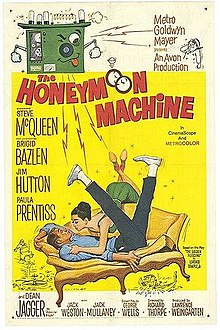The Honeymoon Machine
| The Honeymoon Machine | |
|---|---|
 Theatrical 1961 film release poster by Reynold Brown | |
| Directed by | Richard Thorpe |
| Written by | George Wells |
| Based on | The Golden Fleecing by Lorenzo Semple Jr. |
| Produced by | Lawrence Weingarten |
| Starring | Steve McQueen Brigid Bazlen Jim Hutton Paula Prentiss Dean Jagger Jack Weston Jack Mullaney |
| Cinematography | Joseph LaShelle |
| Edited by | Ben Lewis |
| Music by | Leigh Harline |
| Distributed by | Metro-Goldwyn-Mayer |
Release date |
|
Running time | 84 minutes |
| Country | United States |
| Language | English |
The Honeymoon Machine is a 1961 film directed by Richard Thorpe and starring Steve McQueen, Brigid Bazlen, Jim Hutton, Paula Prentiss, Jack Mullaney, and Dean Jagger, based on the 1959 Broadway play The Golden Fleecing by Lorenzo Semple Jr.. In the film, three men devise a plan to win at roulette with a United States Navy computer. The scheme works until an admiral ruins their plans.[1]
Plot[]
Civilian scientist Jason Eldridge runs Magnetic Analyzer Computing Synchrotron (MACS), a vacuum tube computer aboard the United States Navy ship USS Elmira. He and his friend Lt. Ferguson Howard realize that, by using MACS to record a roulette table's spins over time, the computer can predict future results. Howard and LTJG Beauregard Gilliam check into a Venice casino's hotel dressed as civilians with Eldridge, defying Admiral Fitch's order that naval officers on shore avoid the casino and wear uniforms. They plan to use signal lamps to communicate with a confederate manning MACS on the Elmira.
At the hotel, dedicated bachelor Howard meets and romances Julie Fitch, the admiral's daughter. Eldridge reunites with former girlfriend and heiress Pam Dunstan, in Venice to marry another man. The betting system is very effective, and the three men accumulate hundreds of thousands of dollars in casino chips; the money gives Eldridge the confidence to propose to Dunstan. However, Admiral Fitch sees and investigates their signals; soon the Navy, the American and Soviet consulates, and Venice city authorities are on alert for a "revolution".
The gamblers get Signalman Burford Taylor, who finds their signal lamp, drunk to detain him, but Taylor escapes and reports to the admiral. Julie Fitch tells her father that she and Howard have "got to marry" each other to save him from court-martial. The Soviets accuse the Navy of using MACS to steal from the casino. To avoid an international incident Howard agrees to intentionally lose all his chips on his last bet, but a riot breaks out between Soviets, Americans, and Italians in the casino over the chips. The movie ends with newlyweds Howard and Fitch celebrating their honeymoon in the hotel.
Cast[]
- Steve McQueen as Lt. Ferguson 'Fergie' Howard. McQueen was second choice for this role, after Cary Grant turned the part down.[2]
- Brigid Bazlen as Julie Fitch
- Jim Hutton as Jason Eldridge
- Paula Prentiss as Pam Dunstan
- Dean Jagger as Admiral Fitch
- Jack Weston as Signalman Burford Taylor
- Jack Mullaney as Lt. Beauregard 'Beau' Gilliam
- Marcel Hillaire as Inspector of casino games
- Ben Astar as Russian consul
- William Lanteau as Tommy Dane
- Ken Lynch as Capt. James Angle
- Simon Scott as Capt. Harvey Adam
Reception[]
Bosley Crowther, critic for The New York Times was unimpressed, writing "It is a wild and labored operation, and when it finally comes to an end, one wonders whether it has even been bona fide farce."[3] He did, however, appreciate the efforts of the main cast: "It profits by pleasant performers. Jim Hutton, Jack Mullaney and Steve McQueen work hard as the three connivers."[3]
Steve McQueen walked out of the first public sneak preview and vowed never to work for MGM again despite being under contractual obligation for two more pictures.[2]
According to MGM records, the film made a profit of $122,000.[4]
See also[]
References[]
- ^ The Honeymoon Machine at the American Film Institute Catalog.
- ^ a b Eliot, Marc (2011). Steve McQueen: A Biography. NY: Three Rivers Press. ISBN 978-0307453228. Retrieved 30 December 2017.
- ^ a b Bosley Crowther (August 24, 1961). "Honeymoon Machine". The New York Times.
- ^ The Eddie Mannix Ledger, Los Angeles: Margaret Herrick Library, Center for Motion Picture Study.
External links[]
- 1961 films
- English-language films
- 1961 comedy films
- American films
- American comedy films
- American films based on plays
- 1960s English-language films
- Films directed by Richard Thorpe
- Films set in Italy
- Metro-Goldwyn-Mayer films
- Roulette films
- Films with screenplays by George Wells
- Films scored by Leigh Harline